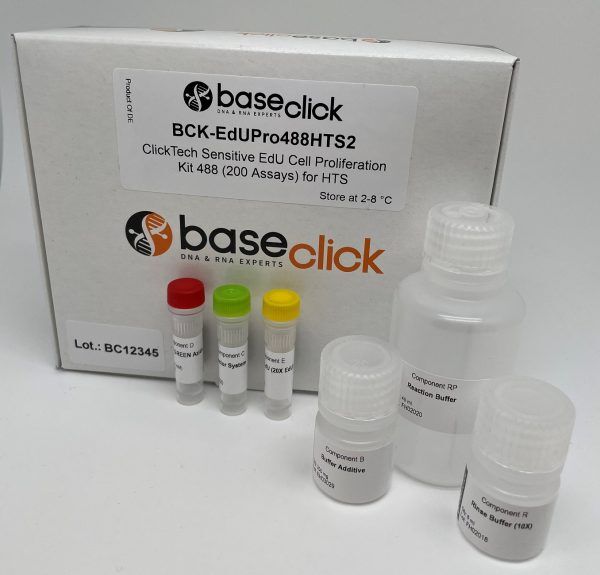Sensitive EdU Cell Proliferation Assay for High-Throughput Screening
ClickTech Sensitive EdU Cell Proliferation Kit for HTS

| Size | Catalog No. | Price |
|---|---|---|
| Dye 488 / 2x 96 well plates | BCK-EdUPro488HTS2 | € 410,00 |
| Dye 488 / 4x 96 well plates | BCK-EdUPro488HTS4 | € 620,00 |
Chemical Properties
-
Shelf Life
12 months unopened after receipt
-
Storage Conditions
2-8 °C
-
Physical State
kit system made of different components
-
CAS Number
n.a.
-
Excitation (max)
Dye 488: 496 nm
-
Emission (max)
Dye 488: 516 nm
-
Ɛ (max)
Dye 488: 83.000 cm-1M-1
-
Preparation/Handling
please see user manual of the kit
Product Information
High-throughput DNA synthesis detection with minimal cytotoxicity and automation-ready workflow
ClickTech Sensitive EdU Cell Proliferation Kit for HTS is engineered for large-scale screening in 96-well and higher-density formats, delivering precise, reproducible quantification of cell proliferation for drug discovery, toxicity profiling, and compound libraries. The assay uses EdU (5-ethynyl-2′-deoxyuridine) incorporation during DNA synthesis and a bioorthogonal click reaction with picolyl-azide fluorophores, ensuring bright, stable signals and minimal background, ideal for high-content analysis across diverse cell types.
Automation Compatibility
- Fully compatible with liquid handling robots and automated plate washers
- Optimized for automated reagent dispensing and high-content screening platforms
- Seamless integration with LIMS and data analysis pipelines
- Reagent volumes and incubation times tailored for robotic scheduling
- Minimal manual intervention, ideal for unattended batch processing
Key Benefits
- Exceptional Sensitivity with low background: Optimized labeling chemistry and picolyl‑azide fluorophore deliver high signal‑to‑noise even in sparse wells (≈ ≥ 500 cells/well) and low‑proliferation conditions.
- Non-Radioactive & Safer: Eliminates hazards of [³H]-thymidine and BrdU; no harsh treatments or specialized equipment.
- Fast, Simplified Workflow: Complete the assay in under 2 hours, no DNA denaturation or antibody steps; fully automation-ready.
- Low Copper, High Viability: The click step is formulated with reduced copper versus conventional EdU protocols, supporting cell health during longer incubations and preserving compatibility with downstream readouts.
- Automation-Ready: Assay timings, wash steps, and reagent additions are tuned for liquid handlers, automated plate washers, and unattended batch processing, with consistent performance across plates, days, and operators.
- Scalable & Reproducible: Bioorthogonal chemistry supports thousands of wells with consistent performance across plates and runs.
Recommended workflow (plate‑ready)
- Cell preparation & EdU pulse: Seed cells in black, clear‑bottom plates. Pulse with EdU during the intended window (e.g., 15–120 min). Short pulses capture S‑phase entry; longer pulses give cumulative labeling for slow cyclers.
- Fix & permeabilize: Apply standard aldehyde fixation followed by mild permeabilization to retain morphology and antigenicity for imaging or multiplex staining.
- Click detection: Add the picolyl‑azide 488 dye cocktail. Incubate under gentle conditions, wash.
- Optional multiplex: Introduce viability dyes, phenotypic markers, or nuclear stains (for HCS segmentation) as needed.
- Readout:
- Plate reader: bottom read with 488‑compatible excitation and 516 nm emission filter.
- HCS/Imaging: use the green channel; quantify EdU‑positive nuclei or integrated intensity per cell.

Plate normalization tip: include row/column controls to support ratio‑based normalization and drift correction; monitor Z′‑factor and well‑to‑well CV before production runs.
Applications
- High-throughput proliferation and cell-cycle screening
- Genotoxicity and mechanism-of-action studies
- Anticancer compound profiling and SAR workflows
- Stem cell proliferation and differentiation monitoring
- Orthogonal readouts with viability/apoptosis markers or HCS imaging
LITERATURE
EdU Incorporation To Assess Cell Proliferation and Drug Susceptibility in Naegleria fowleri. 2021, Antimicrob Agents Chemother.
https://doi.org/1128/AAC.00017-21
Multiplexed and reproducible high content screening of live and fixed cells using Dye Drop. Nature Communications. 2022.
https://doi.org/10.1038/s41467-022-34536-7
Efficient Tandem Copper‐Catalyzed Click Synthesis of Multisugar‐Modified Oligonucleotides. Angewandte Chemie International Edition, e202405161.
https://doi.org/10.1002/anie.202405161
FAQ
-
Does this kit work in 384/1536‑well plates?
Yes. It is optimized for 96/384 and compatible with 1536 after miniaturization; adjust seeding density and reagent volumes proportionally.
-
Is click chemistry compatible with high‑content imaging?
Yes. The workflow preserves morphology and epitopes, enabling EdU measurement alongside phenotypic markers and nuclear stains in the 488 channel.
-
How tolerant is the assay to DMSO from compound libraries?
It is compatible with typical screening solvent ranges; confirm tolerance for your cell model and instrument settings.
-
How does it compare to BrdU‑based HTS?
It avoids DNA denaturation and anti‑BrdU antibodies, reducing processing time and improving compatibility with imaging and fragile targets.
-
What’s a good starting point for the EdU pulse?
A common starting point is ~10 µM for ~2 h, then refine duration and concentration for your cell type and desired dynamic range.

